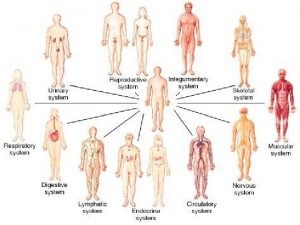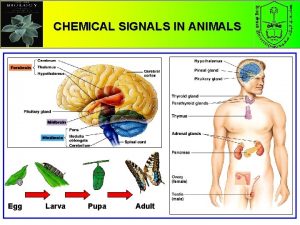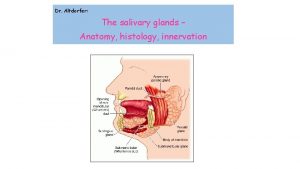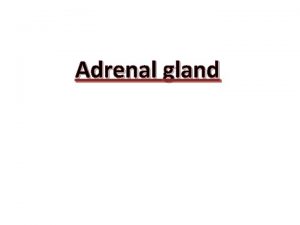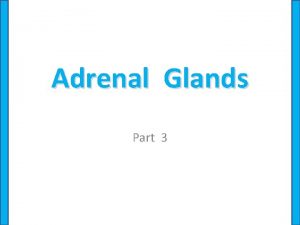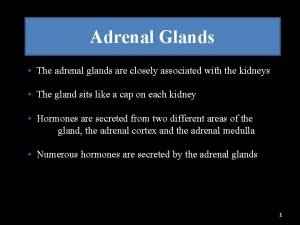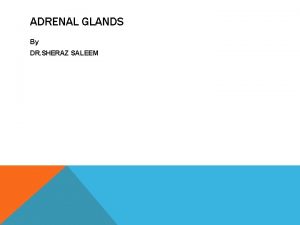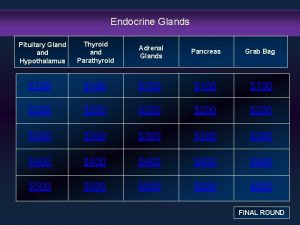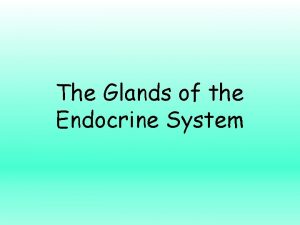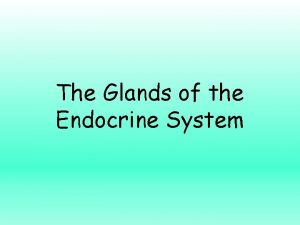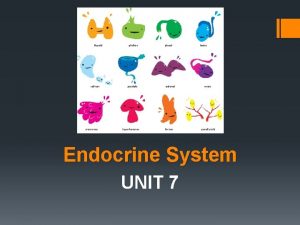Histology of the Endocrine System Adrenal glands Dr























- Slides: 23

Histology of the Endocrine System Adrenal glands Dr. Ahmed Abdulhussein AL-Huchami

Location of the adrenal (suprarenal) gland, human US Federal Government

Suprarenal gland has two parts that are of different embryonic origin, these are: 1. Cortex (90%) – derived from the genital ridge of the mesoderm. 2. Medulla (10%) – derived from neural crest cells.

Adrenal (suprarenal) gland Source Undetermined

Human adrenal, low power LM Bailey’s Histology

Adrenal cortex Zona glomerulosa – Main hormone: Aldosterone (a mineralocorticoid). – General function: Maintain blood electrolyte balance. – Main control: Angiotensin II. Zona fasciculata – Main hormone: Cortisol (a glucocorticoid). – General function: Includes regulating glucose and fatty acid metabolism, and response to stress. – Main control: Pituitary ACTH. Zona reticularis – Hormones: Some cortisol androgens. – Function and control: Similar to zona fasciculata.



Adrenal cortex, human, LM Hadley Kirkman slide collection, slide K 285

glomeruloza Outer layer forming 15% pyramidal and arranged in rounded or arched groups that are surrounded by capillaries. � Their nuclei are rounded and central while cytoplasm is lightly basophilic

Adrenal cortex, human, H&E, LM Humio Mizoguti, Kobe Univ Sch Med, slide 547

Zona glomerulosa (source of aldosterone), LM Fasciculata Humio Mizoguti, Kobe Univ Sch Med, slide 548

Zona fasciculata: It is the thickest layer (65 – 80%) of the adrenal cortex Cells are large polyhedral with rounded central nucleus and pale foamy cytoplasm. These cells are arranged in parallel columns of 1 or 2 cells thickness. The cytoplasm of zona fasciculata cells contains numerous lipid droplets � During slide preparation (by typical histological procedures) lipid is extracted, thus gives vacuolated or spongy appearance to these cells and that's why they are called Spongyocytes.

Zona fasciculata (source of cortisol), LM Humio Mizoguti, Kobe Univ Sch Med, slide 549

Zona reticularis: Thin layer (10%) It consists of small rounded cells that are arranged in branching and anatomizing cords. Cells have rounded central nucleus and deeply basophilic cytoplasm (because they contain fewer lipid droplets and more lipofuscin pigment). This layer secrets the weak androgen (dehydroepiandrosterone - DHEA) which is converted to testosterone in several other tissues

Zona reticularis, LM Medulla Zona fasciculata Humio Mizoguti, Kobe Univ Sch Med, slide 550

Adrenal medulla The adrenal medulla is composed of large, pale-staining polyhedral cells arranged in cords or clumps and supported by a reticular fiber network. When medullary cells are exposed to an oxidizing agent such as potassium bichromate caticholamines (adrenalin and noradrenalin) will be oxidized giving a brown coloration to their cytoplasm, therefore these cells are called chromaffin cells and the reaction is called Chromaffin reaction. Unlike cells of the cortex , contain many granules, contain one or more of the catecholamines, epinephrine or norepinephrine. About 80% of the catecholamine secreted from the adrenal is epinephrine.

Adrenal medulla Hormones – Epinephrine (adrenalin) and norepinephrine (noradrenalin), both catecholamines. Two cell types, one for E and one for N. – General function: Acute response to stress. – Main control: Preganglionic sympathetic innervation. . Also called "chromaffin cells" – Cells of the adrenal medulla are examples of "chromaffin cells, " containing catecholamine granules that stain brown with potassium dichromate. Neurons of sympathetic ganglia are also chromaffin cells. The term is used in pathology.

Adrenal medulla, LM Humio Mizoguti, Kobe Univ Sch Med, slide 565

EM of adrenal medulla: norepinephrine and epinephrine cells Nucleus Norepinephrine Epinephrine Nucleus Stan Erlandsen Medical Histology Slide Collection, slide MH 9/G/2 -P



THANK YOU
 Endocrine glands
Endocrine glands Adrenal glands
Adrenal glands Reproductive organ system
Reproductive organ system Epitelio glandular holocrino
Epitelio glandular holocrino Major endocrine glands male and female
Major endocrine glands male and female Endocrine
Endocrine Difference between endocrine and exocrine glands
Difference between endocrine and exocrine glands Are endocrine glands ductless
Are endocrine glands ductless Thyroid gland cells
Thyroid gland cells Whats the difference between endocrine and exocrine glands
Whats the difference between endocrine and exocrine glands Chapter 11 endocrine system
Chapter 11 endocrine system Endocrine glands
Endocrine glands What are chemical signals
What are chemical signals Endocrine system
Endocrine system Hyophysis
Hyophysis Endocrine system of rat
Endocrine system of rat Lining epithelium of the stomach
Lining epithelium of the stomach Thyroid and parathyroid glands
Thyroid and parathyroid glands Intercalated duct histology
Intercalated duct histology Lamina propria of tongue
Lamina propria of tongue Follicular epithelium
Follicular epithelium Pheochromocytoma
Pheochromocytoma Pituitary and optic chiasm
Pituitary and optic chiasm Endocrine system and reproductive system
Endocrine system and reproductive system


